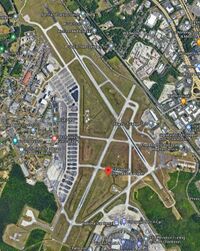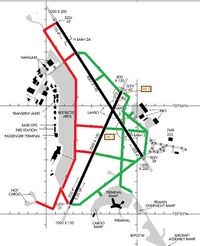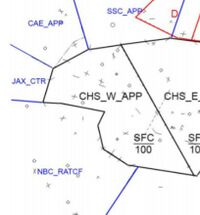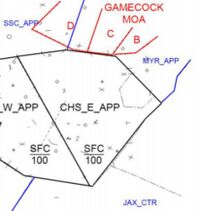Charleston AFB ATCT/TRACON: Difference between revisions
(Created page with "== Table of Updates == {| class="wikitable" style="width: 100%;" |+ !Date !Revision !Items Revised |- |4 May 2023 |A |Update of Organization/Adding of Satellites. |} == Area Information == {| class="wikitable" style="width: 100%;" |+ !ICAO Code !Airport Name !Airspace !IFR Beacon Codes !VFR Beacon Codes |- |KCHS |Charleston Air Force Base/International Airport |C |7301-7337 |7301-7337 |} <br> {| class="wikitable" style="width: 100%;" |- | style="width: 60%;" |<b...") |
No edit summary |
||
| Line 8: | Line 8: | ||
|4 May 2023 | |4 May 2023 | ||
|A | |A | ||
|Update of Organization/ | |Update of Organization/Movement and Nonmovement Areas | ||
|} | |} | ||
| Line 213: | Line 213: | ||
<tabs> | <tabs> | ||
<tab name="Area of Responsibility"> | <tab name="Area of Responsibility"> | ||
LC | LC is responsible for providing air traffic control services on all active runways. LC is also responsible for the CHS Local Control Departure Area.<br> | ||
[[File:CHS_LC.JPG|200px|thumb|left|Local Control Control Departure Area]] | |||
</tab> | </tab> | ||
<tab name="Active Runway Selection"> | <tab name="Active Runway Selection"> | ||
The active runway shall be determined based on wind and known | The active runway shall be determined based on wind and known | ||
factors that may affect the safety of takeoff/landing operations.<br> | factors that may affect the safety of takeoff/landing operations.<br> | ||
North Operations is designated as the calm wind runway.<br> | |||
<ul> | |||
<li><b>North Ops:</b> Arriving: Runway 33 - Departing: Runway 3</li> | |||
<li><b>South Ops:</b> Arriving: Runway 15 - Departing: Runway 21</li> | |||
</ul> | |||
<br> | |||
<i>Occasionally, operational factors may require a shift to Runway 15 and 3 or Runway 33 and 21. These are non-standard configurations and must be coordinated with TRACON. Automatic Releases are cancelled. Departures must be assigned runway heading and 2,000 feet.</i> | |||
<br> | |||
<br> | |||
[https://www.faa.gov/air_traffic/publications/atpubs/atc_html/chap3_section_5.html 7110.65Z Runway Selection] | [https://www.faa.gov/air_traffic/publications/atpubs/atc_html/chap3_section_5.html 7110.65Z Runway Selection] | ||
</tab> | </tab> | ||
| Line 233: | Line 234: | ||
<br>LC shall provide initial radar separation between successive departures. | <br>LC shall provide initial radar separation between successive departures. | ||
<br> When automatic departures are in effect, IFR jet/turbojet departures | <br> When automatic departures are in effect, IFR jet/turbojet departures | ||
shall be released on | shall be released on the RNAV SID for all RNAV departures or fanned heading for NON-RNAV Departures climbing to 4,000 feet.<br> | ||
<b><i>Phraseology</i></b><br> | <b><i>Phraseology</i></b><br> | ||
<span style='color:green;'><b>{Callsign}</b>, <b>{Departure Instruction}</b>, Wind <b>{direction}</b> at <b>{speed}</b>, Runway <b>{Runway}</b>, Cleared for takeoff</span><br> | <span style='color:green;'><b>{Callsign}</b>, <b>{Departure Instruction}</b>, Wind <b>{direction}</b> at <b>{speed}</b>, Runway <b>{Runway}</b>, Cleared for takeoff</span><br> | ||
| Line 257: | Line 257: | ||
</tab> | </tab> | ||
<tab name="Go Around/unplanned Missed Approach"> | <tab name="Go Around/unplanned Missed Approach"> | ||
LC shall assign IFR aircraft runway heading and | LC shall assign IFR aircraft runway heading and 2,000 feet<br> | ||
<B>LC must verbally coordinate with departure prior to frequency change.</b><br><br> | <B>LC must verbally coordinate with departure prior to frequency change.</b><br><br> | ||
<b><i>Phraseology</i></b><br> | <b><i>Phraseology</i></b><br> | ||
| Line 272: | Line 272: | ||
</tab> | </tab> | ||
<tab name="Visual Tower"> | <tab name="Visual Tower"> | ||
Charleston ATCT is a visual/VFR tower and shall not initiate or accept any radar handoffs and shall not initiate control/start track on any target. | |||
</tab> | </tab> | ||
<tab name="ATIS"> | <tab name="ATIS"> | ||
LC shall manage the ATIS for | LC shall manage the ATIS for KCHS<br><br> | ||
The ATIS shall be on | The ATIS shall be on 124.750 | ||
</tab> | |||
<tab name="LAHSO"> | |||
LAHSO operations are authorized at CHS. During LAHSO Operations, if requested by the pilot, issue the following available distances for CHS:<br> | |||
<ul> | |||
<li>Runway 15, available landing distance 5,700 feet.</li> | |||
<li>Runway 33, available landing distance 2,900 feet.</li> | |||
<li>Runway 3, available landing distance 5,500 feet.</li> | |||
</ul> | |||
</tab> | </tab> | ||
</tabs> | </tabs> | ||
| Line 282: | Line 290: | ||
== [[TRACON Information]] == | == [[TRACON Information]] == | ||
<tabs> | <tabs> | ||
<tab name=" | <tab name="CHS_W_APP"> | ||
{| class="wikitable" style="width: 100%;" | {| class="wikitable" style="width: 100%;" | ||
|- | |- | ||
| style="width: 60%;" | | | style="width: 60%;" |WR (CHS_W_APP) is the primary "combined" radar position for Myrtle Beach Tracon. No other sectors shall be staffed until the "combined" position is in use. WR may delegate a portion of its airspace to ER.<br> | ||
<br> | <br> | ||
<B>Responsibility</b> <br> | <B>Responsibility</b> <br> | ||
Provide Overflight Services, approach/departure sequence, and, where required, uncontrolled operation services to aircraft landing in the | Provide Overflight Services, approach/departure sequence, and, where required, uncontrolled operation services to aircraft landing in the Charleston Tracon Airspace. | ||
<br> | <br> | ||
<br> | <br> | ||
<b>Jurisdiction</b> | <b>Jurisdiction</b><br> | ||
WR area of jurisdiction is the CHS approach control airspace west of the Runway 15/33 extended centerline, surface up to 10,000’ MSL. WR is responsible for departure control for westbound. | |||
| style="width: 30%;" |[[File: | | style="width: 30%;" |[[File:CHS W APP.JPG|200px|thumb|left|WR Area of Jurisdiction]] | ||
|} | |} | ||
</tab> | </tab> | ||
<tab name=" | <tab name="CHS_E_APP"> | ||
{| class="wikitable" style="width: 100%;" | {| class="wikitable" style="width: 100%;" | ||
|- | |- | ||
| style="width: 60%;" | | | style="width: 60%;" |ER (CHS_E_APP) is the secondary radar position for Charleston Tracon. WR may delegate a portion of its airspace to ER.<br> | ||
<br> | <br> | ||
<B>Responsibility</b> <br> | <B>Responsibility</b> <br> | ||
Provide Overflight Services, approach/departure sequence, and, where required, uncontrolled operation services to aircraft landing in the | Provide Overflight Services, approach/departure sequence, and, where required, uncontrolled operation services to aircraft landing in the Charleston Tracon Airspace. | ||
<br> | <br> | ||
<br> | <br> | ||
<b>Jurisdiction</b> | <b>Jurisdiction</b> | ||
ER area of jurisdiction is the CHS approach control airspace east of the Runway 15/33 extended centerline, surface up to 10,000’ MSL. ER is responsible for departure control for eastbound | |||
| style="width: 30%;" |[[File: | traffic. | ||
| style="width: 30%;" |[[File:CHS E APP.JPG|200px|thumb|left|ER Area of Jurisdiction]] | |||
|} | |} | ||
</tab> | </tab> | ||
| Line 314: | Line 323: | ||
<b><i>Phraseology</i></B><br> | <b><i>Phraseology</i></B><br> | ||
<span style='color:green;'><b>{Callsign}</b>, squawk <b>{squawk code}</b>.</span><br><br> | <span style='color:green;'><b>{Callsign}</b>, squawk <b>{squawk code}</b>.</span><br><br> | ||
If an aircraft departs from | If an aircraft departs from CHS and does not request a flight following, the aircraft will be handed off from LC to TRACON and released to UNICOM once clear of the Class Charlie.<br> | ||
<br> | <br> | ||
<b><i>Phraseology</i></B><br> | <b><i>Phraseology</i></B><br> | ||
| Line 321: | Line 330: | ||
</tab> | </tab> | ||
<tab name="Handoff and Radar Tracking"> | <tab name="Handoff and Radar Tracking"> | ||
Charleston ATCT is a VFR tower. No radar handoffs shall be initiated to LC.<br> | |||
TRACON controllers shall not drop the track on any arriving aircraft. This allows a controller to maintain radar identification during missed approach. | TRACON controllers shall not drop the track on any arriving aircraft. This allows a controller to maintain radar identification during missed approach. | ||
<br> | <br> | ||
<b><i>Phraseology</i></B><br> | <b><i>Phraseology</i></B><br> | ||
<span style='color:green;'><b>{Callsign}</b>, Contact | <span style='color:green;'><b>{Callsign}</b>, Contact Charleston Tower on {frequency}.</span><br> | ||
</tab> | </tab> | ||
<tab name="Release and Rolling Calls"> | <tab name="Release and Rolling Calls"> | ||
TRACON sectors give automatic releases to all departures from | TRACON sectors give automatic releases to all departures from Charleston ATCT when departures follow the standard departure procedures as specified in this document.<br> | ||
All other airports within TRACON’s boundaries shall request a departure release. Upon approval of the release, the release shall be good for five minutes.<br> | All other airports within TRACON’s boundaries shall request a departure release. Upon approval of the release, the release shall be good for five minutes.<br> | ||
Upon issuance of the takeoff clearance, a departure message shall be sent to the appropriate departure sector. This can be accomplished non-verbally by the LC ensuring the aircraft is squawking the appropriate squawk code and mode C is enabled when airborne. <br><br> | Upon issuance of the takeoff clearance, a departure message shall be sent to the appropriate departure sector. This can be accomplished non-verbally by the LC ensuring the aircraft is squawking the appropriate squawk code and mode C is enabled when airborne. <br><br> | ||
| Line 344: | Line 353: | ||
Provide airspace for missed approach on all runways.<br><br> | Provide airspace for missed approach on all runways.<br><br> | ||
<span style='color:red;'>Note: Ensure notification | <span style='color:red;'>Note: CHS TRACON Ensure notification ZJX AND MYR TRACON if Gamecock Charlie MOA or ROBROY airspace are hot/active.</span> | ||
</tab> | </tab> | ||
<tab name="General TRACON Arrival Procedures"> | <tab name="General TRACON Arrival Procedures"> | ||
| Line 351: | Line 360: | ||
When vectoring to final from parallel downwinds, aircraft on opposing base legs shall be assigned altitudes to ensure vertical separation unless other approved separation has been applied. This ensures separation in the event of an overshoot on final.<br> | When vectoring to final from parallel downwinds, aircraft on opposing base legs shall be assigned altitudes to ensure vertical separation unless other approved separation has been applied. This ensures separation in the event of an overshoot on final.<br> | ||
Coordinate with LC for any aircraft conducting approaches to other runways than the active arrival runway(s) in use. | Coordinate with LC for any aircraft conducting approaches to other runways than the active arrival runway(s) in use. | ||
</tab> | </tab> | ||
</tabs> | </tabs> | ||
Revision as of 15:49, 4 May 2023
Table of Updates
| Date | Revision | Items Revised |
|---|---|---|
| 4 May 2023 | A | Update of Organization/Movement and Nonmovement Areas |
Area Information
| ICAO Code | Airport Name | Airspace | IFR Beacon Codes | VFR Beacon Codes |
|---|---|---|---|---|
| KCHS | Charleston Air Force Base/International Airport | C | 7301-7337 | 7301-7337 |
| Purpose This document prescribes the procedures to be utilized for providing air traffic control services at the Charleston AFB Air Traffic Control Tower (CHS ATCT) and TRACON. The procedures described herein are supplemental to the Jacksonville ARTCC Facility Operating Guidelines and FAA Order JO 7110.65, as well as any published FAA guidelines or procedures. Distribution |
Operational Positions
| Position | Radio Name | Callsign | Relief Callsign | Symbol | Frequency |
|---|---|---|---|---|---|
| Clearance Delivery | Charleston Clearance Delivery | CHS_DEL | CHS_1_DEL | 8CD | 127.325 |
| Ground | Charleston Ground | CHS_GND | CHS_1_GND | 8CG | 121.900 |
| Tower | Charleston Tower | CHS_TWR | CHS_1_TWR | 8CT | 119.500 |
| Position | Sector Name | Callsign | Relief Callsign | Symbol | Frequency |
|---|---|---|---|---|---|
| WR | Radar West | CHS_W_APP | CHS_1W_APP | 8WR | 120.700 |
| RF | Radar East | CHS_E_APP | CHS_1E_APP | 8ER | 119.300 |
Sector in Red is the primary sector.
Clearance Delivery
It is advisable that ALL controllers issues PDCs for departures for KCHS AFB ATCT
PDC Commands
If Charleston Approach or Jacksonville Center is Online: .pdcc {Departure Runway} {Dep Frequency ID}
If Charleston Approach and Jacksonville Center is Offline: .pdccu {Departure Runway}
Initial Altitude for all IFR Departures is 4,000 feet. Pilots shall expect their cruise (if higher) in 10 minutes after departure.
All IFR Aircraft conducting practice approaches shall maintain 2,000 feet
There are five different Standard Instrument Departures from Charleston ATCT
- LGRHD= Loggerhead
- MLTRE= Mull Tree
- PLMTO= Palmetto
- STUNO= Stuno
- SWPFX= Swampfox
Aircraft unable to accept an RNAV departure shall be cleared via radar vectors first filled/Cleared fix.
Phraseology
RNAV Clearance: {Callsign}, You are cleared to the {Arrival Airport} Airport via the {SID NAME} then as filed. Maintain 4,000, expect {cruise} one-zero minutes after departure. Departure Frequency {departure frequency}, squawk {squawk code}.
Non-RNAV Clearance: {Callsign}, You are cleared to the {Arrival Airport} Airport via radar vectors {First Fix} then as filed. Maintain 4,000, expect {cruise} one-zero minutes after departure. Departure Frequency {departure frequency}, squawk {squawk code}.
VFR with or without flight following maintain VFR at or below 3,500 feet.
Myrtle Beach is a class Charlie. All VFR traffic will be issued a discrete squawk code.
Phraseology
{Callsign}, Maintain VFR at or below 3,500 feet, {departure frequency}, squawk {squawk code}.
All VFR remaining in the pattern will require coordination with the tower and will be directed to contact when ready for taxi.
Routings to ZTL, ZMA, ZDC and ZHU ARTCCs have been coordinated through letters of agreements (LOAs).
The table below list the common frequencies used a departures frequencies by MYR Clearance Delivery.This guide is only that, a guide. The actual departure frequency has to determined based on coordination with the other controllers that are online.
| Position | Callsign | Traffic Direction | Symbol | Frequency |
|---|---|---|---|---|
| Radar West | CHS_W_APP | West | 8WR | 120.700 |
| Radar East | CHS_E_APP | East | RE | 119.300 |
Ground
Ground Control does not authorize pushbacks or startups unless the aircraft pushing will enter the controlled area during the pushback.
Phraseology
Aircraft does not enter the controlled area
{Callsign}, Push back and start is at your discretion.
Aircraft does enter the controlled area
{Callsign}, Push and start approved, push tail facing (direction)
The following areas on Non-Movement areas at CHS airport: Joint Base (JB) Charleston Ramp areas and taxiways leading up to the runway hold short lines. This includes all of Taxiway K, D, and E from the ramp to the Runway 15/33 hold short line, and taxiways D, H, F from the ramp to the Runway 3/21 hold short line. Fixed base Operators' designated ramp areas up to but not including taxiways G, G1, and G2. Charleston International Airport Terminal Ramp up to but no including taxiways B, taxiway M, and from the terminal ramp to the movement line on taxiway A.
Aircraft shall be taxied to their location via the short distance.
Phraseology
To Runway
{Callsign}, Runway {Number} taxi via {taxi instructions} {Any Hold Short Instructions}.
To Ramp
{Callsign}, Taxi to the ramp via {taxi instructions} {Any Hold Short Instructions}.
Ground Control must advise Local Control of all intersection departures verbally or through the chatbox in the controller client.
Phraseology
{Callsign}, Runway {Runway Number} at {Intersecting Taxiway}, taxi via {taxiways}.
Ground controller shall ensure each pilot has the current ATIS information prior to being handed off to Local Control
GC must transfer communications to LC if an aircraft is to operate on an active runway.
Phraseology
{Your Callsign}, {Their Callsign} (wait for response)
One to cross runway {number} at {Taxiway} (wait for response)
If Approved: Approved {Their OI} Response: Approved {Your OI}
If Denied: Hold {reason}
Once Crossing Completed: {Your Callsign}, {Their Callsign} (wait for response)
Crossing Complete {Your OI}, Roger {Their OI}
<tab name="Handoffs">
GC shall instruct aircraft to contact tower unless otherwise agreed upon by LC. LC can request pilot monitor the frequency instead of contacting.
Phraseology
{Callsign}, Contact Charleston Tower 126.0
Tower
LC is responsible for providing air traffic control services on all active runways. LC is also responsible for the CHS Local Control Departure Area.
The active runway shall be determined based on wind and known
factors that may affect the safety of takeoff/landing operations.
North Operations is designated as the calm wind runway.
- North Ops: Arriving: Runway 33 - Departing: Runway 3
- South Ops: Arriving: Runway 15 - Departing: Runway 21
Occasionally, operational factors may require a shift to Runway 15 and 3 or Runway 33 and 21. These are non-standard configurations and must be coordinated with TRACON. Automatic Releases are cancelled. Departures must be assigned runway heading and 2,000 feet.
7110.65Z Runway Selection
LC will provide separation for aircraft in the LC airspace.
LC shall provide initial radar separation between successive departures.
When automatic departures are in effect, IFR jet/turbojet departures
shall be released on the RNAV SID for all RNAV departures or fanned heading for NON-RNAV Departures climbing to 4,000 feet.
Phraseology
{Callsign}, {Departure Instruction}, Wind {direction} at {speed}, Runway {Runway}, Cleared for takeoff
{Callsign}, Contact Departure {frequency}
LC shall be responsible for separation of all arrival aircraft that have
been handed off by TRACON from all departing aircraft still under LC
jurisdiction
Phraseology
{Callsign}, {Traffic Advisories} , Wind {direction} at {speed}, Runway {Runway}, Cleared for land
Practice Instrument Approaches: Issue special instructions as verbally coordinated with the
TRACON. Practice Instrument Approaches shall assign runway heading and maintain 2,000 feet. Departure frequency as assigned by approach control.
Phraseology
{Callsign}, Fly Runway Heading, Climb and Maintain 2,000, Contact Approach on {Frequency}
LC shall NOT change the approach sequence without coordination. Communication transfer must be completed prior to five nautical miles
from the runway.
LC shall assign IFR aircraft runway heading and 2,000 feet
LC must verbally coordinate with departure prior to frequency change.
Phraseology
AFTER COORDINATION WITH TRACON: {Callsign}, Fly {Heading}, Climb and Maintain {Altitude}, Contact Approach on {Frequency}
LC is authorized automatic releases from the TRACON controller so long as the aircraft departs on the pre-coordinated active departing runway(s) on approved departure headings
In order for automatic releases to be authorized, procedures in this document shall be followed.
Departure releases must be obtained if automatic releases are suspended by TRACON.
Phraseology
Requesting Release: {Their Callsign}{Your Callsign},
(Hold for answer)
Release for departure, {Airport} {Callsign} {Runway} {First Fix}
(Hold for Answer)
If Approved: Approved{Any Restrictions} {Their OI} Roger, Approved {Restrictions} {Your OI}
If Denied: Hold; Expect clearance at {Zulu} {Their OI} Roger {Your OI}
Charleston ATCT is a visual/VFR tower and shall not initiate or accept any radar handoffs and shall not initiate control/start track on any target.
LC shall manage the ATIS for KCHS
The ATIS shall be on 124.750
LAHSO operations are authorized at CHS. During LAHSO Operations, if requested by the pilot, issue the following available distances for CHS:
- Runway 15, available landing distance 5,700 feet.
- Runway 33, available landing distance 2,900 feet.
- Runway 3, available landing distance 5,500 feet.
TRACON Information
| WR (CHS_W_APP) is the primary "combined" radar position for Myrtle Beach Tracon. No other sectors shall be staffed until the "combined" position is in use. WR may delegate a portion of its airspace to ER.
|
| ER (CHS_E_APP) is the secondary radar position for Charleston Tracon. WR may delegate a portion of its airspace to ER.
|
VFR Aircraft entering the Class Charlie airspace will be given a discrete beacon code.
Phraseology
{Callsign}, squawk {squawk code}.
If an aircraft departs from CHS and does not request a flight following, the aircraft will be handed off from LC to TRACON and released to UNICOM once clear of the Class Charlie.
Phraseology
{Callsign}, Change to Advisory Frequency Approved, squawk 1200.
7110.65Z Class C Service- Terminal
Charleston ATCT is a VFR tower. No radar handoffs shall be initiated to LC.
TRACON controllers shall not drop the track on any arriving aircraft. This allows a controller to maintain radar identification during missed approach.
Phraseology
{Callsign}, Contact Charleston Tower on {frequency}.
TRACON sectors give automatic releases to all departures from Charleston ATCT when departures follow the standard departure procedures as specified in this document.
All other airports within TRACON’s boundaries shall request a departure release. Upon approval of the release, the release shall be good for five minutes.
Upon issuance of the takeoff clearance, a departure message shall be sent to the appropriate departure sector. This can be accomplished non-verbally by the LC ensuring the aircraft is squawking the appropriate squawk code and mode C is enabled when airborne.
Phraseology
Requesting Release: {Their Callsign}{Your Callsign},
(Hold for answer)
Release for departure, {Airport} {Callsign} {Runway} {First Fix}
(Hold for Answer)
If Approved: Approved{Any Restrictions} {Their OI} Roger, Approved {Restrictions} {Your OI}
If Denied: Hold; Expect clearance at {Zulu} {Their OI} Roger {Your OI}
Forward departure instructions to LC for aircraft executing practice missed approaches.
Ensure all departures are on course as soon as practical.
All departures should be on course before handoff to Enroute Control unless otherwise coordinated. Aircraft shall be climbed to 10,000 or less if filed.
Provide airspace for automatic departures and radar final.
Provide airspace for missed approach on all runways.
Note: CHS TRACON Ensure notification ZJX AND MYR TRACON if Gamecock Charlie MOA or ROBROY airspace are hot/active.
The sector responsible for the primary runway shall establish the approach sequence for all arrivals.
Communications transfer of arriving aircraft to LC must be accomplished no later than five nautical miles from the end of the arrival runway.
When vectoring to final from parallel downwinds, aircraft on opposing base legs shall be assigned altitudes to ensure vertical separation unless other approved separation has been applied. This ensures separation in the event of an overshoot on final.
Coordinate with LC for any aircraft conducting approaches to other runways than the active arrival runway(s) in use.




